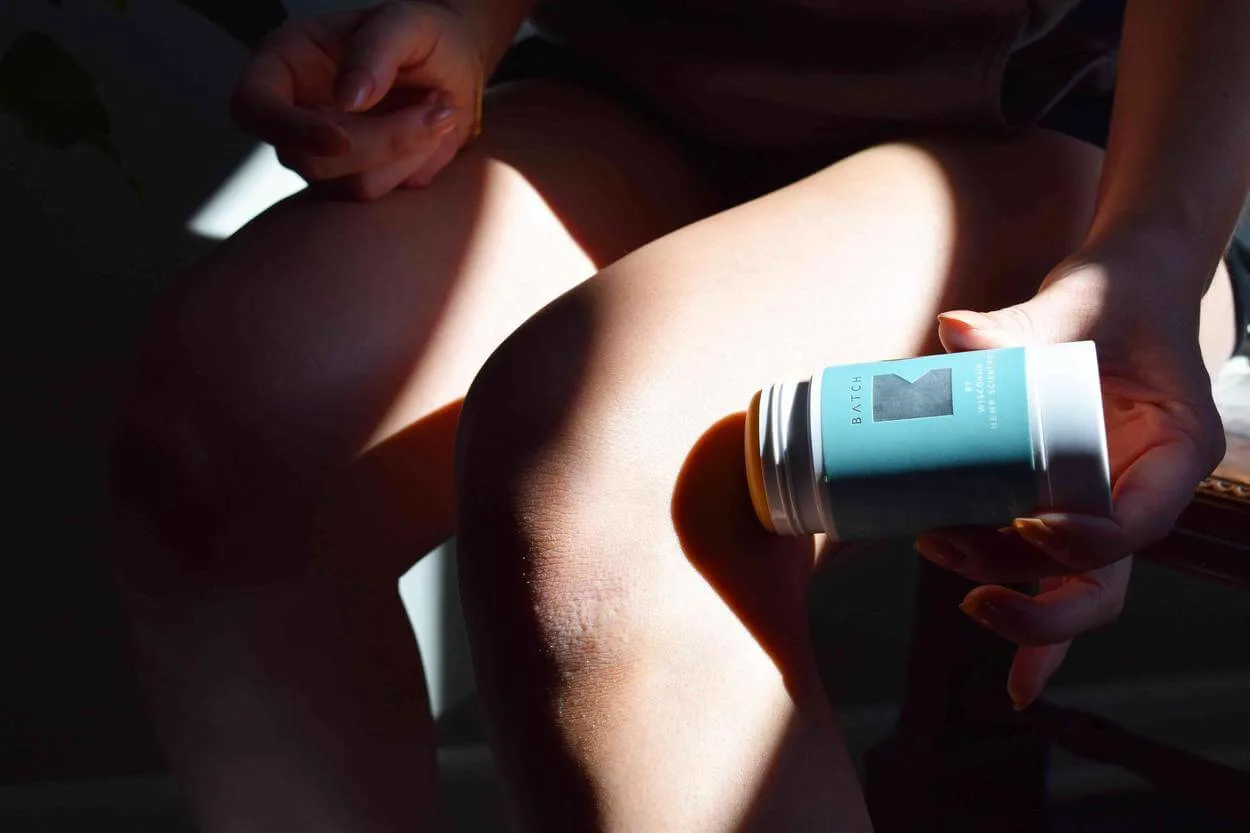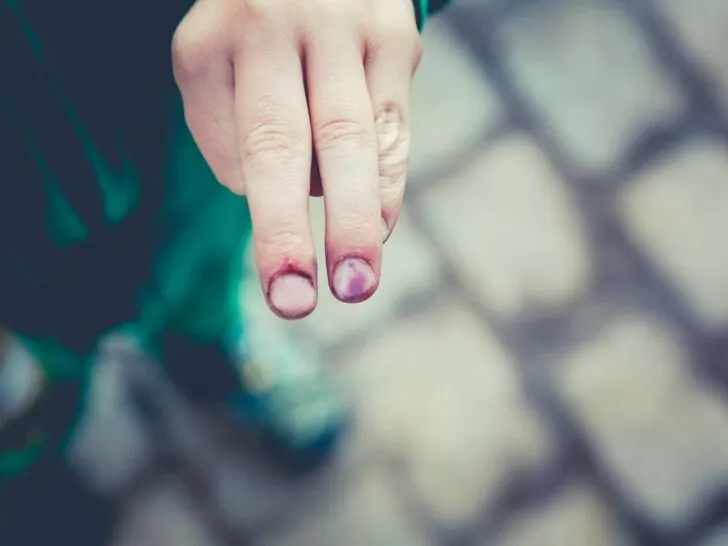Technically, there’s no real difference between the two! They are both sub-dermal hematomas, bleeding under the skin due to broken blood vessels.
However, the difference lies in how each is obtained and how the blood vessels are broken. Besides, a hickey is also considered a bruise because it looks almost identical. But how can you tell them apart?
Here are a few tips and tricks to help you determine between a bruise and a hickey. So let’s get right to it!
What is a Bruise?
A “bruise,” also known as a contusion, is a discoloration caused by the skin or tissue getting damaged mainly by an injury.
Everyone experiences bruising in their life. A bruise can form due to an accident, fall, sports injury, or a medical procedure. Sometimes you might see a bruise and won’t know how and where you got it!
Basically, a bruise forms because this injury causes the blood vessels under the skin to leak as they are damaged, as the blood from these broken vessels accumulates underneath the skin.
This discoloration could range from black, blue, purple, brown, or yellow. In addition, external bleeding could occur only if the skin breaks—many different bruises, such as hematoma, purpura, and black-eye.
Bruises tend to fade away within two weeks without any actual treatment. However, more severe bruises or hematomas can last about a month.
Stages of Bruising
A bruise often starts from being red. This means fresh, oxygen-filled blood has just begun pooling underneath the skin.
After around one to two days, the color changes because the blood loses oxygen. As the days pass, the color shifts towards blue, purple, or black when no oxygen is left.
In about five to ten days, it becomes yellow or green color. This is when the bruise will begin to fade away.
It’ll keep getting lighter and lighter as it heals, from a brown color to completely fading away. It’s completely natural, and it’ll go away in time.
When to Get a Bruise Checked?
Even though bruises can happen randomly, they’re usually not that big of a deal. However, you should immediately consult a doctor immediately if you start noticing any of the following symptoms along with having bruises:
- Abnormal bleeding in gums
- Frequent nose bleeds or blood in the urine
- Numbness or weakness in or around the injured area
- Swelling
- Loss of function in the limb
- Lump under the bruise
Bruises are typically surface injuries and heal independently, but a significant trauma or injury can cause the bruise not to heal. If your bruise isn’t improving for a month, it might be alarming, and you should get it checked!
Why Do Bruises Hurt?
Inflammation is what makes a bruise hurt so badly!
As the blood vessels break open, the body signals the white blood cells to move to that area and heal the injury. They do so by eating away hemoglobin and anything from the vessel.
The white blood cells release substances that cause swelling and redness, known as inflammation. This is what causes the pain. The pain is also there to alarm a person so they can avoid a situation that might cause additional damage in the area.
So you could say that the pain is due to healing, and it’s the way your body alerts you that something different is going on.

How to Heal a Bruise?
There are many techniques you can use to heal a bruise gently yourself. If you’re worried about it and you want it to go away as soon as possible, here are a few tips to help your bruise heal faster:
- Cold compress
As mentioned, icing the area should be one of the first steps. It provides one with so much relief from the pain by numbing the affected area. Ice helps slow the bleeding and shrinks the blood vessels. It also reduces inflammation. - Elevation
Elevating the bruised area comfortably acts in the same way as a cold compress does. It helps slow the bleeding and reduces the overall size of the bruise. - Compression
A soft elastic wrap over the bruise for one to two days can help reduce the pain. The wrap should be firm, but make sure it’s not too tight. The wrap must be loosened or removed if you notice numbness or discomfort. - Topical creams and pain medication
These may help discoloration; you can find it at your nearest pharmacy. You can also take over-the-counter pain medications for relief, such as Tylenol or Panadol.
Remember these tips next time you get a bruise, and they’ll surely help! Don’t massage or rub the bruise, as it may cause more damage to the blood vessels.
What’s a Hickey?
A “hickey” is a dark red or purple mark left on your skin caused by intense suction.
A hickey is the same as a bruise; like other bruises, it also fades away in about two weeks. It’s a slang term for a “bruise” caused by sucking or kissing a person’s skin during an intense and passionate moment.
Hickeys are associated with romance and sexual feelings. It’s regarded as a reward for an excellent make-out session with your partner.
Some people see hickeys as a turn-on. Dr. Jaber, a certified dermatologist, believes it’s not a hickey that turns a person on, but it’s more related to getting there.
The fact that people know how to get a hickey and the process of making it, along with kissing, causes arousal and “turns on” a person.
However, they also tend to be a mark of shame. And people always need to hide these hickeys, especially those who don’t have a spouse yet. They do this to keep their sexual lives private from others.
How Do You Give a Hickey?
It looks easy, but it’s not.
You have to keep your lips on the same part of the skin and continually kiss it with a little bit of sucking it. This is usually done in the neck because our skin is pretty thin, which means it’s closer to your blood vessels.
You have to do this for about 20 to 30 seconds. That’s tiring, and you won’t see the results right away. It may take up to five or ten minutes to appear on the person’s skin.
Just remember that you just can’t give a hickey to anyone you like. You must always take consent beforehand. Even though some find it pleasurable, others don’t want to roam around with a large bruise, especially their neck.
They may allow you to give them a hickey somewhere they can easily cover it up, such as the lower neck or above the breast. Take a look at this video for a demonstration:
How Long Do Hickeys Last?
Hickeys can last anywhere from two days to two weeks.
A hickey lasts about four days before it ultimately fades away. However, this depends on many factors, such as skin type, color, and the amount of pressure put on sucking.
But if you’re looking for a few ways to make it go away, these tips might help:
- Cold packs or compress
Because a hickey is also a bruise, applying cold or ice over the hickey can control the bleeding and reduce inflammation. This would reduce the hickey in size. - Hot packs and massage
A hot compress can be applied to speed up the healing. Use a clean cloth soaked in warm water or a hot water bottle on the hickey. A heating pad or warm towel can also be used to massage the hickey and remove it. - A COLD SPOON!
You might find this surprising, but a cold spoon can do wonders. You can take a spoon and press it in circular motions. This helps reduce the blood clot and makes the bruise appear lighter. - Concealer
If you’re in a hurry, you can just use a little bit of make-up to cover it in the meantime. You can use concealer and foundation. If the bruise is light, then hopefully, that’ll cover it up.

Hickey vs. Bruises (What’s the Difference)
Bruises tend to be pretty random and can appear anywhere on the body. On the other hand, a hickey is something you could give and receive. And most people tend to put it on some specific regions in your body.
In short, bruises tend to be an accident or an injury. Hickeys are given and taken deliberately.
Hickeys, also known as love bites, are usually considered marks of possession. A partner who is a possessive type would love to give you hickeys to show others that you’re taken.
Moreover, hickeys are also a show of affection and signify that a person is sexually active.
The central question is, how can you identify a hickey and tell it apart from just a normal bruise?
Well, one good way to distinguish it is that bruises can be random shapes and any size, but hickeys tend to be oval or circular. Also, they are more likely to be on a person’s neck. Most hickeys range in between the color red to purple.
Understanding the Emotional and Physical Contrasts: Hickeys vs. Bruises
Before I forget, It’s pretty mind-blowing how a bruise can give a person so much pain, but a hickey provides a person with arousal and pleasure.
Maybe because the sexual arousal cancels the pain out, but who knows!
A secret tip: If you see a bruise on someone in their softer areas and are in a very jolly mood, you can tell they got a hickey! Because a painful bruise isn’t going to make anybody that happy.
Here’s a table summarizing a few differences between hickeys and bruises:
| Hickey | Bruise |
| Oval in shape- made by a mouth | Any shape or size |
| Produced mainly by suction | Created by inward pressure, Like banging a body part hard |
| People enjoy getting them- pleasure! | People find them painful |
| Hickeys are caused on purpose | Bruising is mostly accidental |
Final Thoughts
- Hickeys and bruises are sub-dermal hematomas. These stem from broken blood vessels beneath the skin.
- The distinction lies in how each is acquired. Bruises result from injuries, whereas hickeys come from intense suction or kissing.
- Bruises, caused by damaged tissue, change color as they heal. While hickeys, often associated with romance, are purposefully created.
- Bruises can vary in shape and size. In contrast, hickeys are typically oval or circular and found on the neck.
- Hickeys can bring pleasure associated with passion. In contrast, bruises tend to be painful and accidental.
- Healing a bruise involves cold compresses, elevation, compression, and pain relief. In contrast, hickeys can be managed with cold or hot packs, massage, or concealer.
- Depending on various factors, both can last from a few days to a few weeks. They may require different healing methods.
- Recognizing these distinctions allows you to have clarity in communication. It ensures the accurate representation of marks on the skin.
Other Articles You Might Like
- WELLBUTRIN VS ADDERALL: USES, DOSAGE, & EFFICACY
- 34D, 34B AND 34C CUP- WHAT’S THE DIFFERENCE?
- HOW MANY PUSH-UPS PER DAY WILL MAKE A DIFFERENCE?
The shortened web story version can be found by clicking here.

